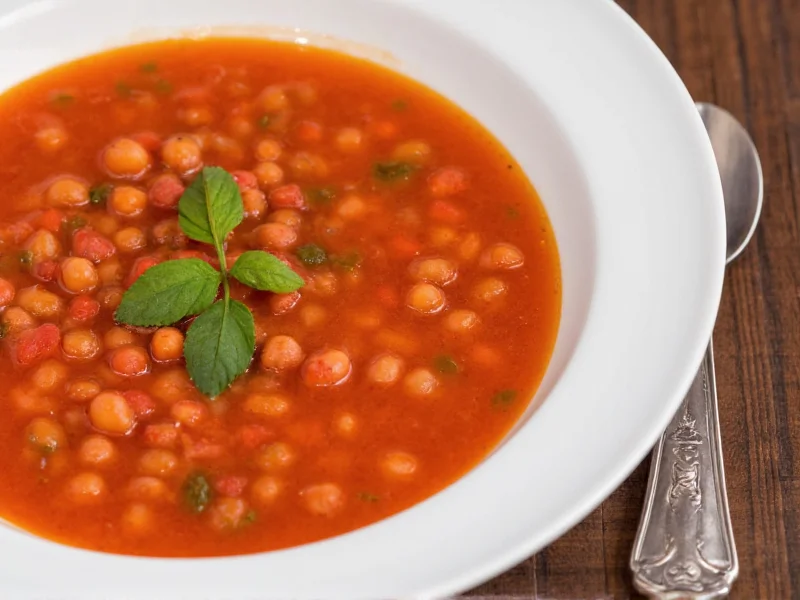The Cultural Roots of Red Pea Soup
Red pea soup's journey from humble beginnings to beloved Caribbean staple reflects centuries of cultural adaptation. Despite common confusion with European split pea soups, authentic red pea soup—called "peas soup" in Jamaica and Trinidad—centers on kidney beans (Phaseolus vulgaris), not peas. Historical records show that kidney beans, native to South America, were introduced to the Caribbean during the Columbian Exchange in the 16th century. By the 19th century, the dish had evolved into its current form through the fusion of African culinary techniques and indigenous ingredients. The following timeline illustrates key milestones in its development:
| Time Period | Key Development | Historical Source |
|---|---|---|
| 16th Century | Kidney beans introduced to Caribbean via Spanish colonizers during Columbian Exchange | Encyclopædia Britannica |
| 19th Century | Recipe standardized in Jamaica/Trinidad using salted meats, root vegetables, and Scotch bonnet peppers | FAO Traditional Food Systems Documentation |
Red Pea Soup vs. Split Pea Soup: Key Differences Clarified
Understanding the distinction between these similarly named soups prevents culinary confusion. While both are hearty legume-based dishes, their ingredients, origins, and flavor profiles differ significantly. This comparison clarifies common misconceptions:
| Feature | Red Pea Soup | Split Pea Soup |
|---|---|---|
| Primary Legume | Whole red kidney beans (Phaseolus vulgaris) | Split yellow or green peas (Pisum sativum) |
| Geographic Origin | Caribbean (Jamaica/Trinidad) | Northern Europe |
| Flavor Profile | Robust, spicy (Scotch bonnet peppers), meaty (if using salted meats) | Mild, earthy, often with ham hock |
| Historical Documentation | FAO records Caribbean bean stews since 1800s [1] | University of Illinois Extension notes European split pea traditions [2] |
Essential Ingredients for Authentic Red Pea Soup
Creating an exceptional red pea soup requires attention to ingredient quality and proper preparation techniques. The foundation begins with dried red kidney beans, which must be properly soaked to ensure even cooking. Unlike canned beans, dried varieties provide superior texture and allow complete control over sodium content. Traditional recipes include:
- Dried red kidney beans (properly soaked overnight)
- Fresh thyme sprigs
- Scotch bonnet pepper (for authentic Caribbean heat)
- Onion, garlic, and scallions
- Carrots and potatoes for natural sweetness
- Optional protein additions like salted beef or smoked turkey
Step-by-Step Cooking Process
Preparing red pea soup requires patience but yields remarkable results. Start by soaking dried kidney beans for at least 8 hours. Drain and rinse thoroughly before adding to a large pot with fresh water. Bring to a boil, then reduce to a simmer. Add aromatics including thyme, garlic, and Scotch bonnet pepper (pierced but left whole for controlled heat). After 30 minutes, incorporate vegetables and any meat components. The soup needs 1.5-2 hours of gentle simmering until beans are tender but not mushy. For optimal texture, mash some beans against the pot’s side during the final 20 minutes of cooking.
Nutritional Benefits of Red Pea Soup
Red pea soup delivers impressive nutritional value that makes it an excellent addition to any balanced diet. The combination of kidney beans and vegetables creates a complete nutritional profile that supports various health goals.
| Nutrient | Per Serving (1.5 cups) | Health Benefit |
|---|---|---|
| Protein | 18g | Supports muscle maintenance and repair |
| Dietary Fiber | 15g | Promotes digestive health and satiety |
| Iron | 25% DV | Essential for oxygen transport in blood |
| Potassium | 20% DV | Supports healthy blood pressure levels |
| Vitamin B6 | 15% DV | Aids in metabolism and brain function |
These nutritional advantages come with contextual considerations. The high fiber content (15g per serving) may cause gastrointestinal discomfort when introduced abruptly to low-fiber diets, as noted by the National Institutes of Health which recommends gradual increases to prevent bloating [3]. Similarly, individuals managing kidney conditions should consult healthcare providers about potassium intake (20% DV per serving), per National Kidney Foundation guidelines on bean consumption [4].
Perfecting Your Red Pea Soup Technique
Mastering red pea soup requires attention to several key techniques. Never add salt during the initial cooking phase, as this can prevent beans from softening properly. Instead, season toward the end of cooking. For optimal flavor development, sauté aromatics separately before adding to the soup. The Scotch bonnet pepper should remain whole with a small slit to control heat level – remove it when desired spiciness is achieved. For creamier texture without dairy, blend approximately one-third of the finished soup and return it to the pot. This technique creates luxurious mouthfeel while maintaining the soup’s authentic character.
Variations and Serving Suggestions
While traditional red pea soup stands beautifully on its own, several variations accommodate different dietary preferences. For a vegan version, omit meat components and use vegetable broth. Some Caribbean households add dumplings made from flour, butter, and water for added heartiness. Others incorporate yams or breadfruit for regional authenticity. Serve red pea soup with boiled green bananas or hard dough bread for a complete meal. The soup’s robust flavor profile pairs exceptionally well with a simple side salad of cucumber and tomato. Leftovers often taste even better the next day as flavors continue to meld.
Storage and Reheating Guidelines
Proper storage ensures your red pea soup maintains quality and safety. Cool the soup completely before transferring to airtight containers. Refrigerated soup stays fresh for 4-5 days, while frozen portions maintain quality for up to 3 months. When reheating, add small amounts of water or broth as the soup thickens upon standing. Never partially reheat and refreeze, as this creates food safety risks. For best results, thaw frozen soup overnight in the refrigerator before reheating gently over medium-low heat.











 浙公网安备
33010002000092号
浙公网安备
33010002000092号 浙B2-20120091-4
浙B2-20120091-4